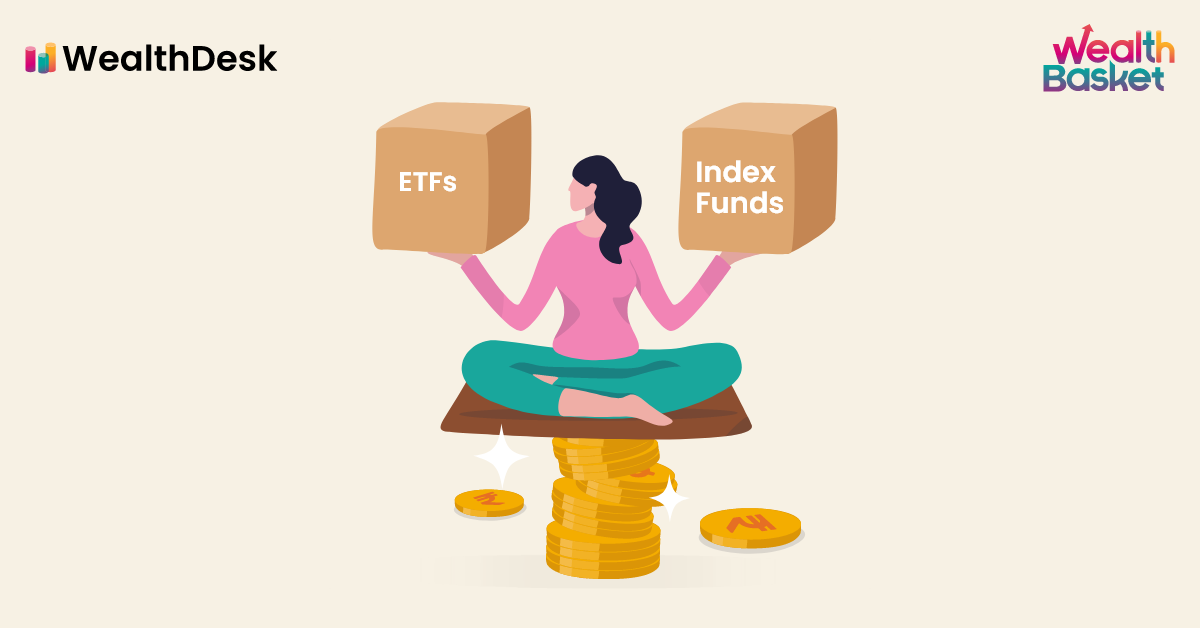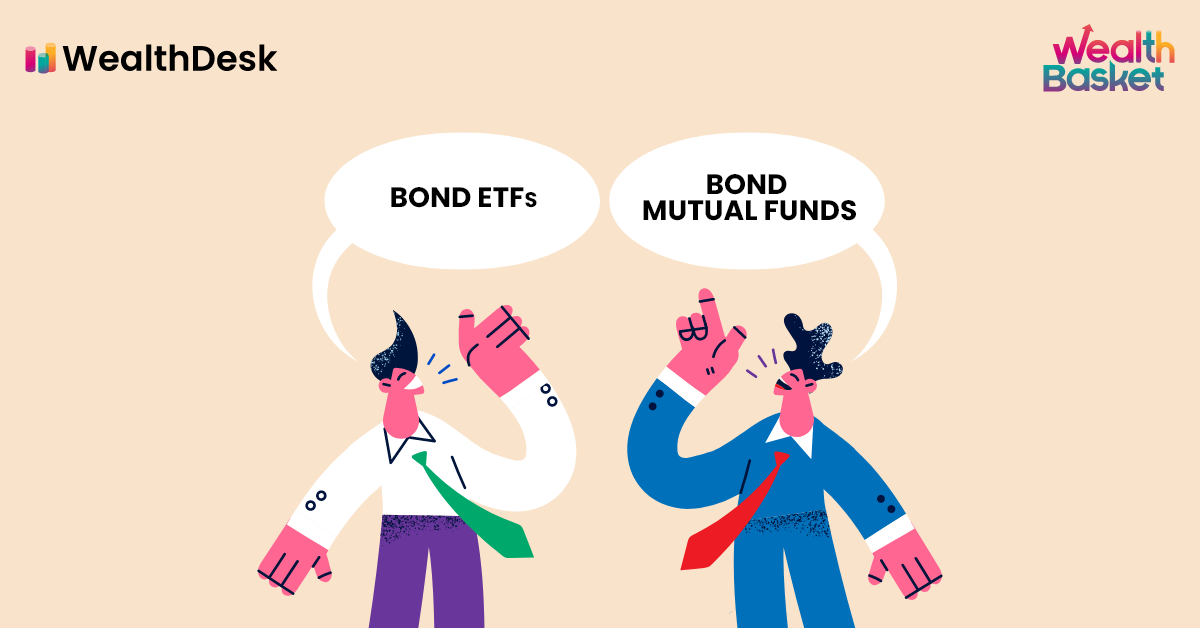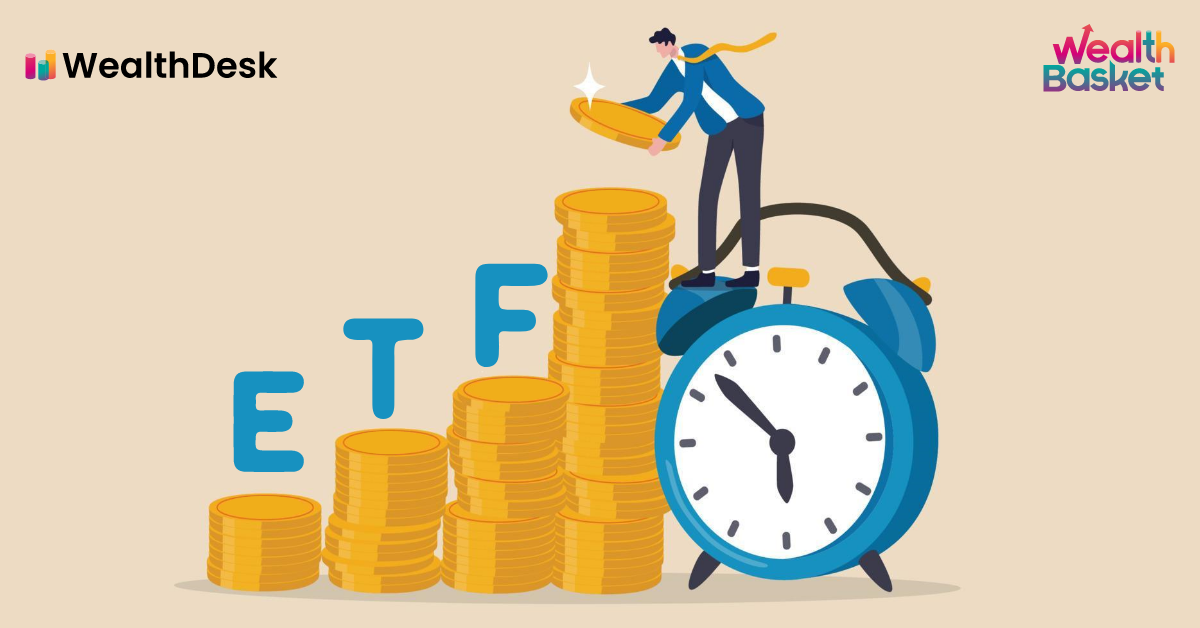Although ETF and index funds might look similar, there’s a fine line of difference. An Exchange Traded Fund is not a new concept. It is a basket or collection of instruments having a particular category, allowing investors to invest in all such securities at a fraction of the cost of individual securities. The first ETF was created back in 1993 in Canada. The ETF markets in India have increased in the past decade.
On the other hand, an index fund is a collection of all the securities included in a particular index. Like ETFs, they also allow investors to invest in the collection at a fraction of the cost.
What is an ‘ETF’?
If the features of a mutual fund and a stock are combined, they will form exchange-traded funds (ETFs). Just like a mutual fund, an ETF is a pool of different stocks, bonds, or assets offering an opportunity to an investor to invest small amounts of money for a share in the passively managed group of assets. Moreover, an ETF can be bought or sold on an exchange similar to a stock.
Passive management means that the ETFs have a lower expense ratio (amount of fund’s assets used for operational and administrative purposes) than typical mutual funds, implying a higher return ratio for investors.
How Do ETFs Work?
For a better understanding, imagine an ETF like a basket. It invests in different assets across the same investment class, and these assets could be anything, including stocks, bonds, or commodities such as gold and silver.
Each basket holds specific types of securities. For example, a bond basket has corporate or government bonds, and an energy basket holds energy production and distribution stocks. The real estate basket includes stocks of real estate development companies.
Are ETFs a Good Way to Start Investing?
Let’s say you have INR 10,000 and want to buy gold as an investment. The problem is this amount is not enough to buy a substantial amount of gold. In addition to the risk of price fluctuation, there is also an element of storage risk. So instead, it will be a better and safer option to put the money in a gold ETF investment where you do not buy the gold, but a share of a big basket of gold that you can trade on an exchange.
Growth of ETFs
The factors like ease and convenience, combined with a lower entry point than owning assets, have helped ETFs become incredibly successful. There are over 7,000 ETFs across 60+ exchanges worldwide, with over USD ~9 trillion in assets under management (AUM) globally. In the United States (US), ETFs trade approximately ~US $6.6 trillion worth of shares in a year, which is more than the US gross domestic product!
India started its ETF journey in 2001 with its Nifty ETF Fund. There are around 80 ETFs available in India that track different types of securities, with large-cap ETFs forming the majority. A range of ETFs is available for investors to choose from, depending upon the risk appetite and investment philosophy.
The AUM for ETFs has risen over 14 times from 2015 to 2020 to nearly INR 2,47,000 crores, with a compound annual growth rate of over 70%.
Source: Paytm Money
What Is an Index Fund?
To understand index funds, we first need to get a clear understanding of indexes. An index is an indicator or measure of something. In financial terms, an index is a statistical measure of a security or a market.
For example:
- SENSEX indicates the performance of Indian stocks listed on BSE
- NIFTY indicates the performance of Indian stocks listed on NSE
Funds that track an index, such as S&P 500 in the US or Nifty 50 in India, are known as index funds. They include index ETFs and index mutual funds. All index ETFs are tradeable on the market; however, all index funds are not, and this is the difference between index funds and index ETFs.
Simply put, the index fund is a basket of all the stocks included in a particular index with the same weight as their market capitalisation. The weight is balanced periodically to maintain nearly the same return as an index.
Instead of buying all the stocks included in the index individually, index funds offer the opportunity to own a piece of every share in the index at a fraction of the price. It is similar to the basket concept of the ETFs discussed above.
The difference is that the index funds are linked to the entire index (Nifty 50 Index Fund) and not to a particular category of securities or commodities (gold ETF).
Like ETFs, index funds are also passively managed, and hence, have a lower expense ratio, leading to more growth and outperforming actively managed funds in the long term.
Discover stocks that suit certain filter criteria and dive into details to check their WealthBaskets.
Where do Index Funds Invest?
Index funds try to replicate the indices and their movements on an exchange as closely as possible by arranging stocks in the same weight as the index.
The index can consist of bonds, commodities, or currencies. For example, Barclays Capital Aggregate Bond Index contains a mix of mortgage-backed securities, government bonds, and corporate bonds.
Risks of Investing in Index Funds
The index fund returns are slightly lower for the investors than the index because of the deduction of management fees. In case the index declines, the index fund tracking it will follow suit.
The risk in the case of an index fund that tracks bonds is when interest rates rise, bonds depreciate. Index funds also carry a risk of lower returns due to tracking errors.
Difference Between ETF and Index Funds
Index funds are funds that track indices like Nifty 50 or SENSEX. Many ETFs are index funds, but not all. You can find ETFs that are not index funds, for example, smart beta ETFs. In the table below, we explore the differences between index funds and ETFs.
| Factors | EXCHANGE TRADED FUNDS (ETFs) | INDEX FUNDS |
| Definition | An ETF is a collection of securities that usually tracks a particular set of equities and is traded just like a stock in exchange. | An index fund is a collection of securities that tracks and analyses the performance of a particular market index to replicate its proportions. |
| Model Structure | The ETF model is similar to Mutual funds and contains stocks that compose indices such as Sensex or Nifty. It follows two main structures, namely physical and synthetic ETFs. While Physical ETFs tend to follow the results of a market index by either holding all or a sample representing the index’s underlying constituents. Synthetic ETFs replicate the index’s performance using derivatives and swaps rather than physical securities. | The index fund model is all about mimicking stock market insides. Compared to an ETF, it contains more assets in cash or liquid securities. This makes index funds susceptible to tracking errors and can cause them to divulge the returns on the actual indices. |
| Expense Ratio | ETFs have an expense ratio that is less than 1%. However, investors also need to pay a Demat account maintenance charge of 1%. | Typically, index funds have a lower expense ratio than ETFs as they can go as low as 0.1% to 0.05%. Investors also need to pay a fixed transaction fee of Rs.100 when the investment crosses Rs.10,000, in addition to the expense ratio. |
| Main Benefit | ETFs, offer flexibility in terms of investment diversity and trading. Investors can trade ETFs on a very short or long-term basis. | Index funds have low flexibility as they do not allow for diversification and are suitable for those looking into long-term investments. |
| Flexibility | ETFs, offer flexibility in terms of investment diversity and trading. Investors can trade ETFs on a very short or long-term basis. | Index funds have low flexibility as they do not allow for diversification and are suitable for those looking into long-term investments. |
Conclusion
Know better and conduct your research about specific ETFs or Index Funds and learn how to start investing in them wisely by visiting the WealthDesk. WealthDesk provides a researched-backed mix of stocks and portfolios created by SEBI-registered investment professionals to help you diversify your portfolio and improve your returns.
FAQs
The tax on index funds is calculated as per the standard short-term and long-term capital gain provisions, based on their holding period.
Unlike in ETFs, investors investing in the index funds have an option of investing by a SIP of minimum INR 500 or a lump sum of a minimum of INR 5,000.
ETFs require the investors to invest a minimum amount of INR 10,000, and they do not get the option to invest in SIPs. The ETF investment strategy used by the investor could be active trading on the exchange for short-term investment or a long-term horizon.
Whether you choose ETFs or index funds, neither are tax-free. ETFs are taxed based on the underlying asset and can have lower tax liability than index funds. For example, if an ETF has stock holdings, the tax liability will be computed as if ETFs were stocks.


















